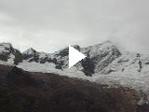As I said in the last entry, Peru’s coast is home to one of the driest deserts in the world. Despite the constant fog, it almost never rains — my tour guide for an exhibit in Lima told me that the last time there was heavy rain was 35 years ago.
All of the water for the city comes from the mountains, where it falls as rain or snow and then melts, filling the rivers. During the dry season, half of the year, almost all of the water is from melting snow and ice. Unfortuantely, almost all of these glaciers are going to melt and dissapear in the next 50 years. It is unclear where Peruvians will get their water from when the glaciers are gone.
The country’s energy supply is also at risk. According to people I talked to at PROCLIM, a project aimed at preparing Peru for global warming, 80% of Peru’s electricity is hydroelectric, and, during the dry season, 80% of the water in the dams is from glacial runoff. Unless investment for huge new dams is found, Peru might have to switch to using fossil fuels to produce its electricity.
All of this will take place in a country where I have already seen many water problems. Most of the towns and cities I have been in (including parts of Lima) have certain hours of the day when the city does not provide water. In one rural area east of the Cordillera Blanca, I met a man working for the government whose job it is to resolve water disputes. ‘It is a big problem here. I have to make sure that each day the water goes to a different house.’ A farmer I stayed with near the coast pointed to a number of his crops and said that they would be twice as high if not for a shortage of water. And every person who lives near a stream tells me the same story: the streams are more variable than they used to be. In the dry season there is less water, and in the rainy season there is more — just as one would expect from a decreasing snow pack. (To be fair, this is also due to deforestation as well as loss of snow and ice.)
Loosing the glaciers and snow of the mountains will be a major loss for Peru. The only solution may be to build many new resivours in the mountains. But, what valleys will they choose to flood? What will happen to the people living in these valleys? And, how will Peru, a poor country, find the investment for such expensive projects?






David:
Very interesting piece on Peru’s water supply. It is a very similar situation to the one we discussed while you were here in Colombia. Global warming will force both glaciers and paramos to shrink, jeopardizing the water supply.
I enjoy your entries a lot. thanks for taking the time.
A. Guhl
Do you know of Bolivian orgs working on climate change preparation?
Hope all is well
Adam Z.
hello..
i am a student from Korea..
i came to this website when i was searching problems of Peru for my report. this is very good and useful information. however, i have a question. Why Peru does not use water from Amazon river, despite it suffer from water shortages. Amazon river origins in Peru. Isn`t it? is there any probles to use water from the river?
REPLY TO CHOI: Choi – that is a good question. Peru, in theory, has some of the largest amount of freshwater in the world. The problem is that it is far away from where the people live – Peruvians live mostly on the coast or in the mountains. The coast is extraordinarily dry, and only some places in the mountains are very wet.
To get water from the Amazon to these places would never be economic! So, even though Peru has lots of water, it is not in a very useful place for the people!
this site is pretty cool. I rili enjoyed reading it and it rili helped me find information for my EM project. it’s also very interesting to actually get to know a little bit more on what happens around us, and it also helps us understand that our little problems next to those are like…nothing…
this is really interesting and sad. I think that all the world´s gotta get toghether to work on a projects for reciclying ad different forms of energy since we have little petroleum.
Is there a way to comunicate with the whole world at the same time?